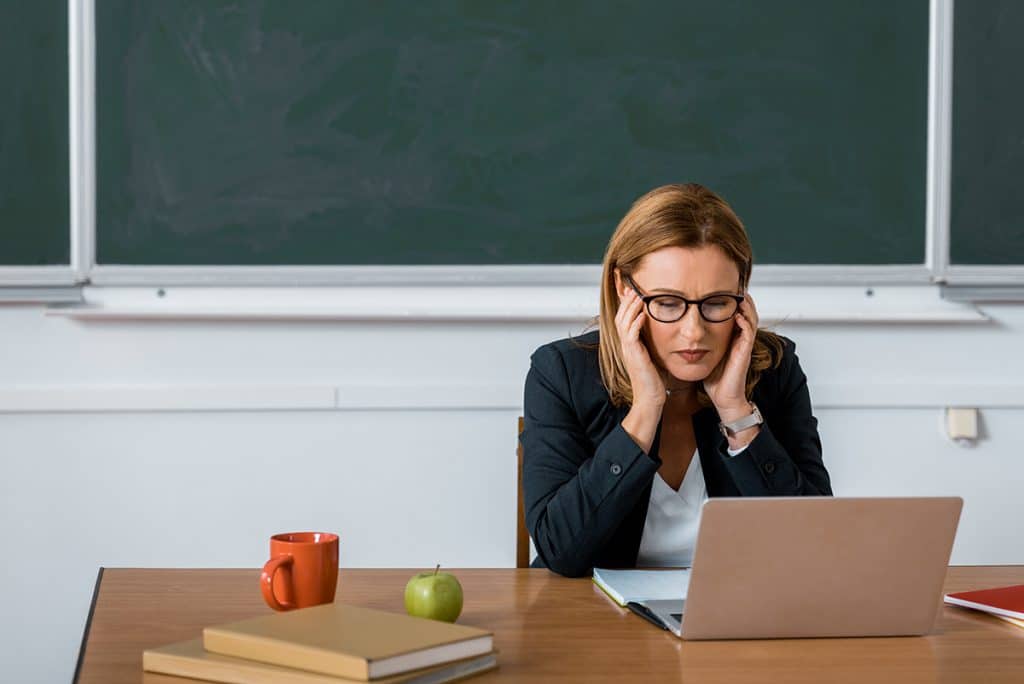Whether you are a new teacher or have been teaching for years, we all get nervous at times. Throughout my teaching career, I have found several strategies to help manage anxiety and how to be less nervous when teaching. Some of these strategies are common sense and some are a bit more out of the box. Here are my top 15 strategies for How To Be Less Nervous When Teaching.
Table of Contents
- 15 Ways to Be Less Nervous When Teaching
- FAQ’s For Teacher Anxiety
- Final Thoughts On Reducing Stress While Teaching
15 Ways to Be Less Nervous When Teaching

Practice Breathing Exercises
Seems simple, right? However, it’s not as simple as it sounds. Research has proven that just the act of stopping, breathing in deeply, and exhaling slowly causes a physiological response and will help you center your thinking. It’s a great model for your students as well.
Ask for Help
Don’t be afraid to ask for help. If your nervousness and anxiety are overwhelming, speak to mentors, administration, and your HR department. They are there to help you. Your school probably participates in the EAP (Employee Assistance Program) which provides a specified number of sessions with mental health professionals.
Know Your Material
Throughout my career, I have found that I am more relaxed when I know what I am talking about. Students can sense when you are confident and when you aren’t. If you know your material/subject matter, you will answer questions with authority. In addition, knowing the subject you are teaching well gives you the confidence to diagnose and fix any misunderstandings your students may have. This will lead to less anxiety about the instructional choices you make daily.
Be Prepared
Have you ever heard the adage, “fail to plan, plan to fail”? This is very true in the teaching profession. A teacher who isn’t well planned and prepared is a teacher who will not reach their potential and increase anxiety and nervousness. Teachers must frontload lessons by preparing all supplies ahead of time. Scrambling around to gather manipulatives five minutes before a lesson will undoubtedly lead to increased anxiety and nervousness. Take the time the afternoon before to make sure those dice are ready to go for tomorrow, or those hundreds charts and dry erase markers are at the ready. This includes teacher materials as well. Make sure you have all your supplies, physical and digital. Make sure your links are hot for your presentation. Make sure you have the copies and materials you need to successfully present the material to your students.
Have a Contingency Plan
I think schools have perfected Murphy’s Law, “if anything can go wrong, it will.” With that in mind, it is always a stress reliever to have a backup or, contingency plan. If the lamp in your projector blows, what are you going to do? Creating a contingency plan box is a great strategy to combat this. Create a go box of educational activities that will help students review and practice necessary skills. This will keep them engaged while you can solve the emergency without being nervous about being in charge of chaos, which always happens. This resource is also great for substitutes and others who might come in to cover your class. This will decrease nerves and anxiety for everyone involved.
Create Relationships
It is much easier to lead a group that you know well. Often, they are more receptive and will naturally put you more at ease. Students seek strong relationships with trusted adults at all levels. If you can develop a relationship with students that is based on mutual respect and care, then your nervousness and anxiety while teaching will naturally decrease. It also just makes the classroom a more pleasant and relaxed place.
Practice Self-Care
This is a bit of a cliche at this point, but, still very true. We cannot take care of others and be confident in who we are and what we do if we don’t take care of ourselves first. Self-care can be as different as the people who practice it. Your self-care may look like a long hike through a park or national forest. It may look like a night of playing games on your phone. The point is, to take care of you in whatever way makes sense for your well-being.
Have a Focal Point
One of the best strategies in public speaking or performing is to have something to focus on. Choose a point, object, or place in the room to focus on as you teach. When you become nervous or anxious, focus on that and breathe. Count to five and begin again. It will help you re-center yourself and be able to calm your thoughts.

Be Mindful
Mindfulness is a practice that has been around for thousands of years through yoga and meditation. Those are not the only ways to be mindful, however. It is not practical to use yoga poses when you are teaching. Mindfulness in a teaching situation might look like this. When you feel yourself getting nervous, begin to ground yourself through your senses; the brightness of the lights, the hardness of your chair or the floor you’re standing on, the smells, the sounds, anything to put yourself in the moment. Nervousness and anxiety are products of overthinking. Mindfulness brings that overthinking into check and helps you recenter.
Create a Fun Environment
A classroom setting can be stressful and anxiety-ridden for everyone involved, from the teacher to the best student in the class to the student who is struggling the most. Doing things intentionally to bring fun into the classroom relaxes everyone. For example, games can be a great way to decrease stress. Leaving Easter eggs throughout your lessons can also help relax the atmosphere. Just like in many popular movies, teachers can leave small hints about crazy facts, extra credit points, small prizes, et cetera. It keeps the atmosphere light and students on their toes. This will reduce your nervousness by creating a light-hearted environment.
Remember Your Purpose
No one says they went into teaching for the money. Most of us feel that it is a calling. Once you remember the reason why you are there, you can relax and do what you feel you were called to do. Children are very forgiving and welcoming, as a rule. When they know someone is there for them, they will respond in kind. When you have that confidence, the nervousness and anxiety often just melt away.
Tapping
Tapping is a mental health strategy to reduce anxiety and other mental health issues. It works on the Chinese use of acupuncture/acupressure points. It is systematic and patterned. It is an intense answer to intense fear in the classroom. Check our FAQ section for more information.
Mentorship
Teaching is not a solo career. Teachers must build community in their schools and look to others for advice and input. Find a mentor or use the mentor you are assigned to have, someone to share your strengths and needs with. They will be able to offer insight into you and ways you can calm your fears and nerves over being in a classroom.
Set Schedules and Routines
Schedules and routines help calm our fears. They help teachers, and their students, know what to expect. This relieves fears and helps everyone be on the same page.
Stay Healthy
This aligns with self-care. Teaching is a stressful, physical job in many ways. If you are not in your best health, you will not be able to fight intense feelings of nervousness and anxiety. Drink your water, get enough sleep, and keep your doctor’s appointments.

FAQ’s For Teacher Anxiety
Where can I find more information on the tapping technique? The Tapping Solution has basic, free resources for tapping basics.
If you feel comfortable, speak to your administrator and ask for information. If you prefer not to speak to your direct administrator, then speak with your HR department. You can also refer to the HHS website, for more information.
The best way to do this is to speak with mentors and colleagues who know the culture of the school. In addition, do some self-reflecting on how you want your classroom to flow. This article is a great resource for that.
Final Thoughts On Reducing Stress While Teaching
In closing, we all get nervous when speaking or presenting to others. We all let anxiety get the best of us. For teachers, however, the stakes can be much higher. It is so important for the well-being of the students we serve, as well as our careers. Using these 15 strategies will help you calm your nerves and anxiety as you step into that classroom. If these feelings become too overwhelming, please, seek help. These are strategies that I have found effective in reducing nerves in the classroom. I hope they help you in your classroom.
